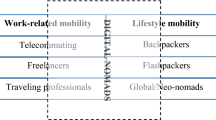Abstract
This paper provides an introduction to digital tourism as mediated by presence research as a means to create substantive user experiences (UX) for visitors. Tourism is a rich and varied socio-economic activity that permeates our global society. Digital tourism is the digital support of the tourist experience. In this paper we introduce and survey both fields and introduce a number of examples of tourist experiences based on our blended spaces approach. Cutting across this is the sense of presence that visitors can experience in real or digital tourist experiences. We conclude the paper with a discussion of designing the user experience in blended tourist spaces.



Similar content being viewed by others
References
Abowd GD, Atkeson CG, Hong J, Long S, Kooper R, Pinkerton M (1997) Cyberguide: a mobile context-aware tour guide. Wireless Networks 3, 5, pp 421–433
Allsop L (2011) iPhone app brings Roman London to life. http://articles.cnn.com/2011-07-29/tech/roman.london.app_1_iphone-app-london-museum-roman-london?_s=PM:TECH
Apted T, Kay J, Quigley A (2006) Tabletop sharing of digital photographs for the elderly. In: Grinter R, Rodden T, Aoki P, Cutrell E, Jeffries R, Olson G (Eds) Proceedings of the SIGCHI conference on human factors in computing systems (CHI ‘06), ACM, New York, pp 781–790
Ardissono L, Goy A, Petrone G, Segnan M, Torasso P (2003) Intrigue: personalized recommendation of tourist attractions for desktop and handset devices. Applied artificial intelligence, special issue on artificial intelligence for cultcommunities of agents
Baudisch P, Rosenholtz R (2003). Halo: a technique for visualizing off-screen objects. In: Proceedings of the SIGCHI conference on human factors in computing systems (CHI ‘03). ACM, New York, pp 481–488
Benyon D (2012) Presence in Blended Spaces. Interacting with Computers
Cheverst K, Mitchell K, Davies N (2002) The role of adaptive hypermedia in a context-aware tourist GUIDE. Communications of the ACM 45, 5, pp 47–51
Cruz-Neira C, Sandin D, DeFanti T (1993) Surround-screen projection-based virtual reality: the design and implementation of the CAVE. In: Proceedings of the 20th annual conference on computer graphics and interactive techniques (SIGGRAPH ‘93). ACM, New York, pp 135–142
De Carolis B, Novielli N, Plantamura V, Gentile E (2009) Generating comparative descriptions of places of interest in the tourism domain. In Proceedings of the third ACM conference on recommender systems (RecSys ‘09). ACM, New York, pp 277–280
Durrant A, Golembewski M, Kirk D, Benford S, Fischer J, Rowland D, McAuley D (2011a) Automics: souvenir generating photoware for theme parks. In: Proceedings of the 2011 annual conference on Human factors in computing systems (CHI ‘11). ACM, New York, pp 1767–1776
Durrant A, Golembewski M, Kirk D, Benford S, Rowland D, McAuley D (2011b) Exploring a digital economy design space in theme parks. In: Proceedings of the second conference on creativity and innovation in design (DESIRE ‘11). ACM, New York, pp 273–284
Gorini A, Capideville CS, De Leo G, Mantovani F, Riva G (2011) The role of immersion and narrative in mediated presence: the virtual hospital experience. Cyberpsychol Behav Soc Netw 14(3):99–105
Lee KM (2004) Why presence occurs: evolutionary psychology, media equation, and presence. Presence 13(4):494–505
Lombard M, Ditton T (1997) At the heart of it all: The concept of presence. J Comput Mediat Commun [On-line], 3(2), Available: http://www.ascusc.org/jcmc/vol3/issue2/lombard.html
Milgram P, Kishino F (1994) A taxonomy of mixed reality visual displays. IEICE Trans Inf Sys E77-D:1321–1329
Mokey S, Nalbandian A, O’Keefe B, Benyon D, Mival O, Ayan S (2012) Location as interaction: exploring blended spaces in the global village. In: Proc. HCITOCH 2012. Springer Press
National Parks Services (2012) Edgar Allen Poe National Historic Site, National Park Service. http://www.nps.gov/edal/index.htm
Poe Edgar Allen (1984) Complete stories and poems of Edgar Allen Poe: the tell tale heart. Bantam Doubleday Dell Publishing Group, New York
Quigley A (2009) From GUI to UUI: User interfaces for ubiquitous computing, book chapter in ubiquitous computing fundamentals Chapman & Hall/CRC
Revonsuo A (2006) Inner presence, consciousness as a biological phenomenon. MIT Press, Cambridge
Riva G, Mantovani F (2012) From the body to the tools and back: a general framework for presence in mediated interactions. Interact Comput 24(4):203–210
Riva G, Mantovani F, Capideville CS, Preziosa A, Morganti F, Villani D, Alcaniz M (2007) Affective interactions using virtual reality: the link between presence and emotions. Cyberpsychol Behav 10(1):45–56
Riva G, Waterworth JA, Waterworth EL, Mantovani F (2011) From intention to action: the role of presence. New Ideas Psychol 29(1):24–37
Robinson S, Jones M, Eslambolchilar P, Murray-Smith R, Lindborg M (2010) “I did it my way”: moving away from the tyranny of turn-by-turn pedestrian navigation. In: Proceedings of the 12th international conference on Human computer interaction with mobile devices and services (MobileHCI ‘10). ACM, New York, pp 341–344
Schering A-C, Dueffer M, Finger A, Bruder I (2009) A mobile tourist assistance and recommendation system based on complex networks. In Proceedings of the 1st ACM international workshop on Complex networks meet information & knowledge management (CNIKM ‘09). ACM, New York, pp 81–84
Schinke T, Henze N, Boll S (2010) Visualization of off-screen objects in mobile augmented reality. In: Proceedings of the 12th international conference on Human computer interaction with mobile devices and services (MobileHCI ‘10). ACM, New York, pp 313–316
UNWTO (2011) Tourism highlights, Edition Uriely, 2005
Uriely Natan (2005) The tourist experience: conceptual developments. Ann Tour Res 32(1):199–216
Villani D, Lucchetta M, Preziosa A, Riva G (2009) The role of affective media features on the affective response: a virtual reality study. e-Minds. Int J Hum Comput Interact 1(5):35–55
Watanabe A (2012) Inside ‘world’s first augmented reality hotel’. Retrieved on 14 Mar 2012, http://www.theaustralian.com.au/travel/news/smart-advertising-makes-the-holiday-inn-the-worldss-first-augmented-reality-hotel/story-e6frg8ro-1226298298447
Waterworth JA, Waterworth EL, Mantovani F, Riva G (2010) On Feeling (the) present: an evolutionary account of the sense of presence in physical and electronically-mediated environments. J Conscious Stud 17(1–2):167–178
Witmer BG, Singer MJ (1998) Measuring presence in virtual environments: a presence questionnaire. Presence 7(3):225–240
Author information
Authors and Affiliations
Corresponding author
Rights and permissions
About this article
Cite this article
Benyon, D., Quigley, A., O’Keefe, B. et al. Presence and digital tourism. AI & Soc 29, 521–529 (2014). https://doi.org/10.1007/s00146-013-0493-8
Received:
Accepted:
Published:
Issue Date:
DOI: https://doi.org/10.1007/s00146-013-0493-8




